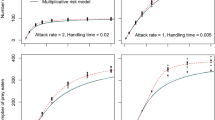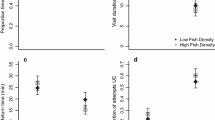Abstract
Interactions between multiple predator species are frequent in natural communities and can have important implications for shared prey survival. Predator density may be an important component of these interactions between predator species, as the frequency of interactions between species is largely determined by species density. Here we experimentally examine the importance of predator density for interactions between predator species and subsequent impacts on prey. We show that aggressive interactions between the predatory shore crabs Carcinus maenas and Hemigrapsus sanguineus increased with predator density, yet did not increase as fast as negative interactions between conspecifics. At low density, interactions between conspecific and heterospecific predators had similar inhibitory impacts on predator function, whereas conspecific interference was greater than interference from heterospecifics at high predator density. Thus the impact of conspecific interference at high predator density was sufficient in itself that interactions with a second predator species had no additional impact on per capita predation. Spatial and temporal variability in predator density is a ubiquitous characteristic of natural systems that should be considered in studies of multiple predator species.



Similar content being viewed by others
References
Abrams PA, Ginzburg LR (2000) The nature of predation: prey dependent, ratio dependent or neither? Trends Ecol Evol 15:337–341
Arditi R, Akcakaya HR (1990) Underestimation of mutual interference of predators. Oecologia 83:358–361
Arditi R, Ginzburg LR (1989) Coupling in predator–prey dynamics: ratio dependence. J Theor Biol 139:311–326
Billick I, Case TJ (1994) Higher order interactions in ecological communities: what are they and how can they be detected? Ecology 75:1529–1543
Bourdeau PE, O’Connor JN (2003) Predation by the nonindigenous Asian shore crab Hemigrapsus sanguineus on macroalgae and molluscs. Northeast Nat 10:319–334
Brousseau DJ, Baglivo JA (2005) Laboratory investigations of food selection by the Asian shore crab Hemigrapsus sanguineus: algal versus animal preference. J Crustac Biol 25:130–134
Brousseau DJ, Kriksciun K, Bagliva JA (2003) Fiddler crab burrow usage by the Asian crab, Hemigrapsus sanguineus, in a Long Island Sound salt marsh. Northeast Nat 10:415–420
Clark ME, Wolcott TG, Wolcott DL, Hines AH (1999) Intraspecific interference among foraging blue crabs Callinectes sapidus: interactive effects of predator density and prey patch distribution. Mar Ecol Progr Ser 178:69–78
Connell JH (1961) The influence of interspecific competition and other factors on the distribution of the barnacle Cthamalus stellatus. Ecology 42:836–849
Crumrine PW, Crowley PH (2003) Partitioning components of risk reduction in a dragonfly-fish intraguild predation system. Ecology 84:1588–1597
DeGraaf JD, Tyrrell MC (2004) Comparison of the feeding rates of two introduced crab species, Carcinus maenas and Hemigrapsus sanguineus, on blue mussel, Mytilus edulis. Northeast Nat 11:163–167
Ebling FJ, Kitching JA, Muntz L, Taylor CM (1964) The ecology of Lough Ine. XIII. Experimental observations of destruction of Mytilus edulis and Nucella lapillus by crabs. J Anim Ecol 33:73–82
Eklöv P, VanKooten T (2001) Facilitation among piscivorous predators: effects of prey habitat use. Ecology 82:2486–2494
Elner RW (1981) Diet of green crab Carcinus maenas (L.) from Port Herbert, southwestern Nova Scotia. J Shellfish Res 1:89–94
Elner RW, Hughes RN (1978) Energy maximization in the diet of the Shore Crab, Carcinus maenas. J Anim Ecol 47:103–116
Finke DL, Denno RF (2002) Intraguild predation diminished in complex-structured vegetation: implications for prey suppression. Ecology 83:643–652
Fretwell SD, Lucas HL (1970) On territorial behavior and other factors influencing habitat distribution in birds. Acta Bioethica 19:16–19
Griffen BD (2006) Detecting emergent effects of multiple predator species. Oecologia 148:702–709
Griffen BD, Byers JE (2006a) Intraguild predation reduces redundancy of predator species in multiple predator assemblage. J Anim Ecol 75:959–966
Griffen BD, Byers JE (2006b) Partitioning mechanisms of predator interference in different habitats. Oecologia 146:608–614
Griffen BD, Delaney DG (2007a) Species invasion shifts the strength of predator dependence. Ecology (in press)
Griffen BD, Guy T, Buck J (2007b) Inhibition between invasives: a newly introduced predator moderates the impacts of a previously established invasive predator. J Anim Ecol (in press). doi: 10.1111/j.1365-2656.2007.01304.x
Hairston NG, Smith FE, Slobodkin LB (1960) Community structure, population control, and competition. Am Nat 94:421–425
Harvey BC, White JL, Nakamoto RJ (2004) An emergent multiple predator effect may enhance biotic resistance in a stream fish assemblage. Ecology 85:127–133
Holling CS (1959) The components of predation as revealed by a study of small mammal predation of the European pine sawfly. Can J Entomol 91:293–320
Jensen GC, McDonald PS, Armstrong DA (2002) East meets west: competitive interactions between green crab Carcinus maenas, and native and introduced shore crab Hemigrapsus spp. Mar Ecol Progr Ser 225:251–262
Lima SL (1998) Stress and decision-making under the risk of predation: recent developments from behavioral, reproductive, and ecological perspectives. Adv Study Behav 27:215–290
Lima SL, Dill LM (1990) Behavioral decisions made under the risk of predation: a review and prospectus. Can J Zool 68:619–640
Lohrer AM, Whitlatch RB (2002a) Interactions among aliens: apparent replacement of one exotic species by another. Ecology 83:710–732
Lohrer AM, Whitlatch RB (2002b) Relative impacts of two exotic brachyuran species on blue mussel populations in Long Island Sound. Mar Ecol Progr Ser 227:135–144
Lohrer AM, Whitlatch RB, Wada K, Yasuo F (2000) Home and away: comparison of resource utilization by a marine species in native and invaded habitats. Biol Invas 2:41–57
Losey JE, Denno RF (1998) Positive predator–predator interactions: Enhanced predation rates and synergistic suppression of aphid populations. Ecology 79:2143–2152
Mansour RA, Lipcius RN (1991) Density-dependent foraging and mutual interference in blue crabs preying upon infaunal clams. Mar Ecol Progr Ser 72:239–246
McDermott JJ (1998) The western Pacific brachyuran Hemigrapsus sanguineus (Grapsidae) in its new habitat along the Atlantic coast of the United States: feeding, cheliped morphology and growth. In: von Vaupel Klein JC (eds) Crustaceans and the biodiversity crisis. Brill, Leiden, pp 425–444
Mistri M (2003) Foraging behaviour and mutual interference in the Mediterranean shore crab, Carcinus aestuarii, preying upon the immigrant mussel Musulista senhousia. Estuar Coast Shelf Sci 56:155–159
Peckarsky BL (1991) Mechanisms of intraspecific and interspecific interference between larval Stoneflies. Oecologia 85:521–529
Saigusa M, Kawagoye O (1997) Circatidal rhythm of an intertidal crab, Hemigrapsus sanguineus: synchrony with unequal tide height and involvement of a light response mechanism. Mar Biol 129:87–96
Schenk D, Bersier L, Bacher S (2005) An experimental test of the nature of predation: neither prey-nor ratio-dependent. J Anim Ecol 74:86–91
Shaw RG, Mitchell-Olds T (1993) ANOVA for unbalanced data: an overview. Ecology 74:1638–1645
Sietz RD, Lipcius RN, Hines AH, Eggleston DB (2001) Density-dependent predation, habitat variation, and the persistence of marine bivalve prey. Ecology 82:2435–2451
Sih A, Englund G, Wooster D (1998) Emergent impacts of multiple predators on prey. Trends Ecol Evol 13:350–355
Smallegange IM, van der Meer J, Kurvers RHJM (2006) Disentangling interference competition from exploitative competition in a crab-bivalve system using a novel experimental approach. Oikos 113:157–167
Soluk DA (1993) Multiple predator effects – predicting combined functional-response of stream fish and invertebrate predators. Ecology 74:219–225
Stephens DW, Krebs JR (1986) Foraging theory. Princeton University Press, New Jersey
Taylor DL, Eggleston DB (2000) Effects of hypoxia on an estuarine predator–prey interaction: foraging behavior and mutual interference in the blue crab Callinectes sapidus and the infaunal clam prey Mya arenaria. Mar Ecol Progr Ser 196:221–237
Tyrrell MC, Harris LG (1999) Potential impact of the introduced Asian shore crab Hemigrapsus sanguineus, in northern New England: diet, feeding preferences, and overlap with the green crab, Carcinus maenas. In: Pederson J (ed) Proc Natl Conf Mar Bioinvas. M.I.T Press, Cambridge, pp 208–220
Vance-Chalcraft HD, Soluk DA (2005a) Estimating the prevalence and strength of non-independent predator effects. Oecologia 146:452–460
Vance-Chalcraft HD, Soluk DA (2005b) Multiple predator effects result in risk reduction for prey across multiple prey densities. Oecologia 144:472–480
Volterra V (1926) Variations and fluctuations in the numbers of individuals in animal species living together. Reprinted in 1931. In: Chapman RN (ed) Animal ecology. McGraw-Hill, New York
Vonesh JR, Osenberg CW (2003) Multi-predator effects across life-history stages: non-additivity of egg- and larval-stage predation in an African treefrog. Ecol Lett 6:503–508
Warfe DM, Barmuta LA (2004) Habitat structural complexity mediates the foraging success of multiple predator species. Oecologia 141:171–178
Acknowledgments
Thanks to D. Niemaszyk for assistance in conducting the field experiments. We thank I. Altman, A. Blakeslee, J. Buck, J. Byers, A. Freeman, T. Guy, W.J. Lee, L. Page, C.H.P. Peterson, O. Schmitz, G. Trussell, and anonymous reviewers for comments on the manuscript. We also thank Shoals Marine Laboratory for use of their facilities. This work was supported in part by an NSF grant to the Shoals Marine Laboratory in support of the Research for Undergraduates program, and by a University of New Hampshire Dissertation Fellowship.
Author information
Authors and Affiliations
Corresponding author
Additional information
Communicated by Pete Peterson.
Rights and permissions
About this article
Cite this article
Griffen, B.D., Williamson, T. Influence of predator density on nonindependent effects of multiple predator species. Oecologia 155, 151–159 (2008). https://doi.org/10.1007/s00442-007-0889-6
Received:
Accepted:
Published:
Issue Date:
DOI: https://doi.org/10.1007/s00442-007-0889-6




